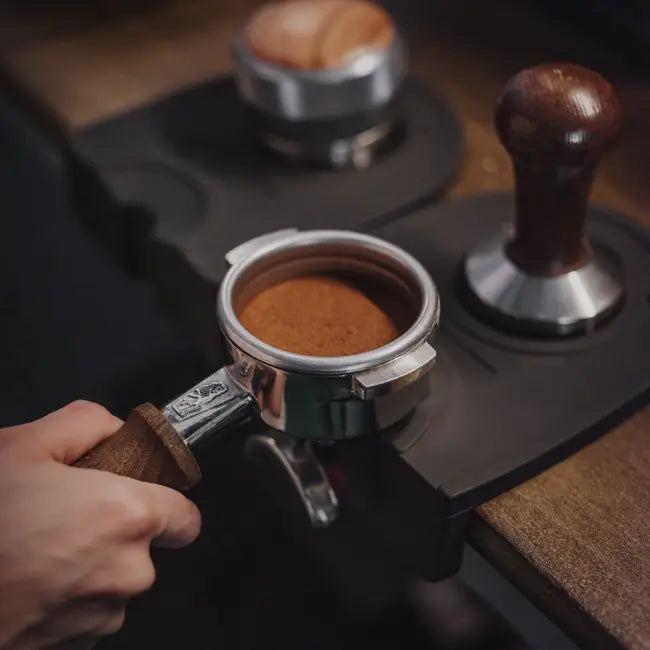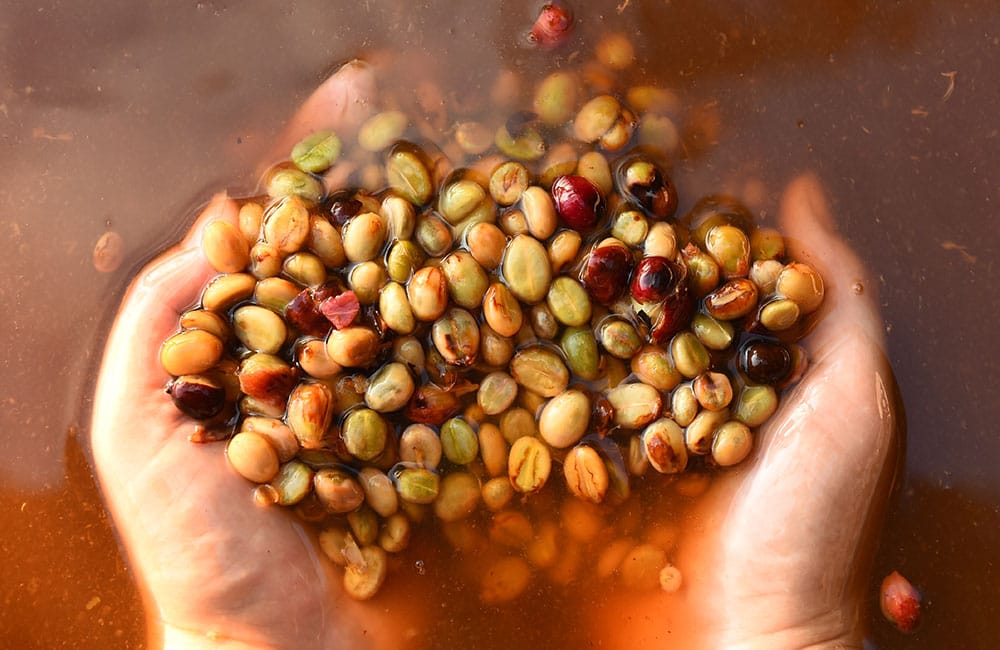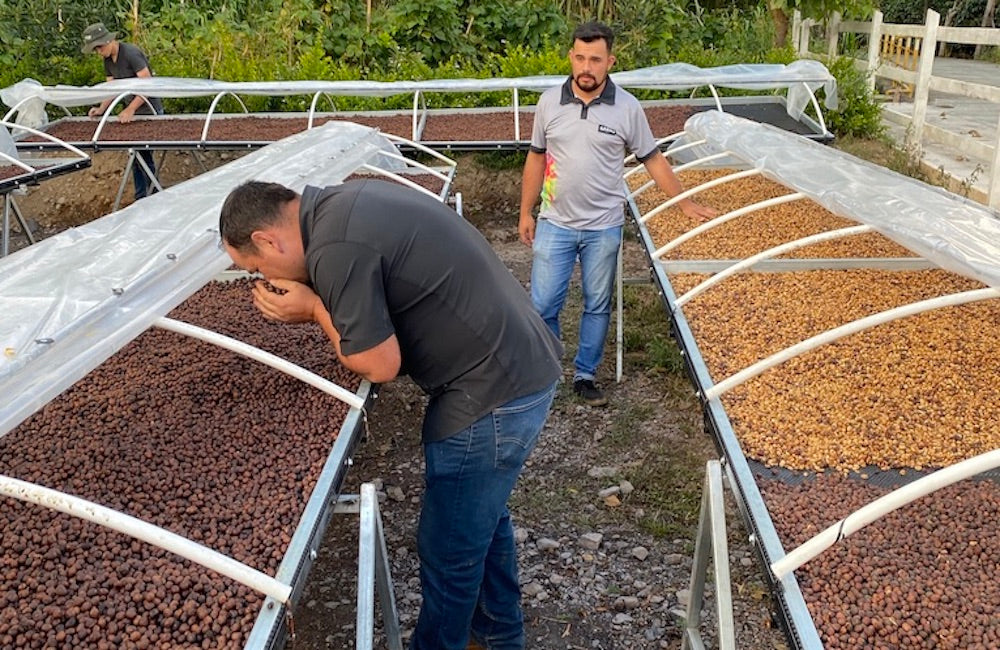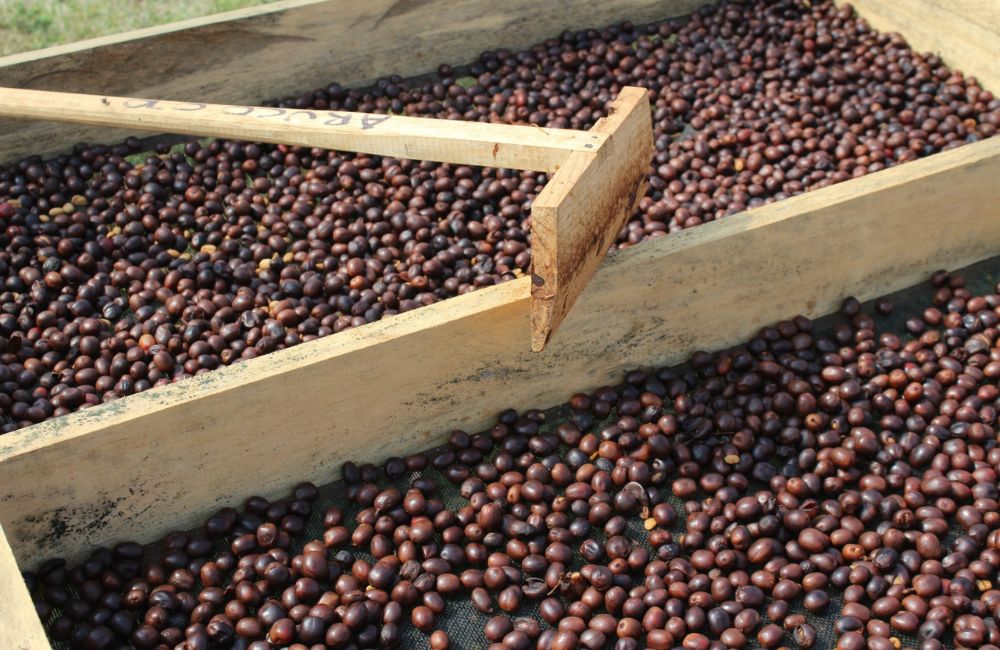¿De qué hablamos cuando hablamos de café lavado?
El café lavado se refiere al proceso por el cual se separan las dos semillas de café de la cáscara y mucílago de la cereza de café antes de pasar al secado.
Esta sería la definición técnica (y súper reducida) de un café lavado, pero para quienes no tienen ciertos conocimientos del mundo de los cafés de especialidad, puede sonar un poco críptica y no aclarar mucho. En este post procuraremos explicarlo de tal manera que no te queden dudas sobre qué significa que un café ha pasado por un “proceso lavado o café lavado”.
También nos referiremos a otras tres formas importantes de procesar el café y que explicaremos en profundidad en artículos separados. Esto son el proceso natural, el proceso honey y la fermentación anaeróbica.
Cerezas de café maduras y recién recogidas antes de ser procesadas
Los diferentes procesos del café
Si nos fijamos en el paquete de un café de especialidad podremos observar que este, generalmente, nos proporciona cierta información. Esta información suele ser: el origen, la variedad, la altura de cultivo, las notas de cata y el tipo de procesado (en este post puedes profundizar más en esta información y cómo reconocer un café de especialidad).
Lo que nos interesa en este post es centrarnos en el tipo de procesado. El tipo de procesado de un café se refiere al orden y la forma en la que se separan las diferentes partes de la cereza de café para dejar las semillas libres y secas, que es lo que comúnmente conocemos como café verde (antes de ser tostado).
Dependiendo de en qué orden suceda esto, dará lugar a tres tipos de proceso diferentes:
1. Proceso lavado (también conocido como húmedo o beneficio húmedo): se separan la cáscara y mucílago del fruto mediante una despulpadora y luego se fermenta la semilla y se lava con agua. Posteriormente se dejan secar las semillas.
2. Proceso natural (también conocido como beneficio seco): se dejan secar las semillas de café, en la misma cereza, y una vez secas se separan las semillas de la pulpa.
3. Proceso honey (también conocido como semi-lavado o pulped natural): se separan la cáscara y pulpa de la cereza pero se deja parte del mucílago y se seca con este, que se elimina después.
4. Fermentación anaeróbica: no es un proceso propiamente dicho, lo podríamos considerar un sub-proceso que se puede utilizar con otros, pero por su impacto en el resultado del café, merece un artículo aparte.
Existen otros procesos y cientos de variaciones intermedias con cambios en los tiempos de fermentación, de secado, de sombra, de sol, de cámaras sin oxígeno, con CO2, etc. Las posibilidades de fermentación y/o procesado del café son infinitas y cada productor elige las variables que mejor potencian y realzan su café.
Anatomía de una cereza de café

Conocer la anatomía de una cereza de café nos ayuda a entender los diferentes procesos del café
Para poder entender bien a qué se refiere cada proceso es útil tener en mente las partes que componen una cereza de café. Esto facilitará que entendamos los diferentes procesos, cómo y por qué tienen diferentes resultados.
Una cereza de café se puede dividir en varias capas concéntricas a las semillas (para una más fácil comprensión y lectura no mencionaremos los nombres botánicos, sino los que se usan en el mundo del café):
- Cáscara (o pulpa): la piel externa que recubre y protege la cereza
- Mucílago: es la parte carnosa de la cereza de café, una capa de textura viscosa entre la pulpa (cáscara) y el pergamino/semilla
- Pergamino: una fina película entre el mucílago y la semilla que une ambas semillas
- Película plateada: fina capa plateada que envuelve cada semilla
- Semilla: las semillas del café. Una cereza de café tiene dos semillas (dos granos de café). En ciertos casos solo desarrolla una semilla y se le llama “caracolillo”.
Fases del proceso del café lavado

Las semillas de café una vez se han despulpado
Hay dos momentos claves para un caficultor: el momento en el que se recogen las cerezas, cuando estas están en su punto óptimo de maduración, y el momento en que se procesan antes de prepararlas para exportar.
Una vez recogidas las cerezas, el caficultor las recibe y tiene que decidir qué proceso utiliza. Generalmente, las estaciones de lavado o los mismos caficultores se especializan en un tipo de proceso y siempre hacen el mismo. El proceso lavado tiene tres fases principales, despulpado, fermentado y secado.
En este caso nos centraremos en el café lavado y sus fases:
1. Selección de cerezas, la cosecha. La selección empieza con la recolección, pero hay una segunda selección de las cerezas haciéndolas flotar. Las que flotan tienen menos consistencia y puede que algún defecto, por lo que se apartan para lotes de menor calidad.
2. Despulpar la cereza. Se separan la cáscara de las semillas con la ayuda de una despulpadora y se lavan con agua
3. Dejar fermentar los granos. Este es un momento crítico. Las semillas se dejan fermentar en tanques de agua diferentes tiempos que suelen oscilar entre 18 y 24 horas.
4. Secado. Una vez las semillas están limpias y con la fermentación deseada, hay que dejarlas secar. Suele hacerse en camas elevadas o sobre una superficie de cemento, al sol o a la sombra y también puede utilizarse una secadora mecánica. Se trata de reducir y estabilizar la humedad de las semillas en el rango deseado, normalmente sobre el 9-12%.
Estas son las fases del procesado de un café lavado. Aunque podríamos entrar en mayores detalles en cada una de ellas, esto nos da una visión general. Lo importante para diferenciarlo de los otros procesos es recordar que, en el café lavado la semilla se despulpa prácticamente en el momento de recogerla, tiene un tiempo de fermentación corto y seguidamente se secan las semillas (solo con el pergamino).
¿Cómo afecta el proceso lavado a la semilla?

En el café proceso lavado las cerezas se despulpan y lavan antes de secarse
Cada tipo de procesado de café produce unas notas de cata diferente. Esto se debe a que las semillas absorben más o menos sabores y azúcares de la cereza, una vez han sido recogidas, dependiendo del tiempo de contacto entre ambas y del proceso de fermentación que ocurre.
En un café lavado las semillas se despulpan en cuanto se recogen. Aunque hay muchos procesos lavados actuales que reposan/fermentan la cereza durante cierto tiempo antes de despulpar. La cereza empieza a fermentar tan pronto se recoge de la planta, por eso el tiempo que se tarde en despulparlas cambiará el perfil final en taza. Los azúcares naturales de la cereza empiezan a descomponerse y fermentarse y pasan partes de sus cualidades organolépticas a la semilla.
Pero realmente el sello de identidad de los cafés lavados generalmente es que se despulpan con rapidez y se dejan fermentar en agua relativamente poco tiempo, para después lavarlos con agua (de ahí su nombre). Como resultado, obtenemos perfiles de sabor que potencian los sabores intrínsecos de la cereza y que asimismo resaltan las cualidades del terreno y el clima donde han sido cultivados. Obviamente la mano profesional y experimentada del caficultor hará que cada fase del proceso lavado sea adecuada y potencie el resultado final.
Perfil de sabor de un café lavado

Los diferentes procesos del café afectan al perfil de cata
Los cafés con proceso lavado son aclamados por su “limpieza” en taza, con sabores definidos y muy reconocibles de acuerdo con la variedad botánica y su área de cultivo. Son perfiles con acidez limpia y balanceada y de los que podríamos decir que el impacto del proceso es más leve y resalta más el sabor intrínseco de variedad botánica y ‘terroir’.
El proceso de fermentación, diferente y más largo de los cafés naturales y honey, por ejemplo, hace que estos tengan notas más afrutadas y más cuerpo. Por otro lado, lo que realmente resalta en los cafés lavados es el grano en sí, la semilla/variedad botánica, y todo lo que tiene que mostrar de su origen, variedad, el ‘terroir’ o altura. Podríamos decir que se nota menos el impacto del tipo de proceso. Es por eso que muchos amantes del café de especialidad lo consideran el proceso más puro, el que más resalta las cualidades de cada café.
Esto no quiere decir que los procesos natural y honey, u otros, sean mejores o peores, simplemente es importante reconocer que el proceso influye en el perfil de taza. Los caficultores han de conocer cómo cada proceso afecta al café para elegir el que mejor resalte sus cualidades.
Y tú, al conocer los diferentes procesos, sabrás que esperar de un café, y también podrás reconocer si ciertas notas se deben más al café o más al tipo de proceso. Al fin y al cabo, hay excelentes cafés con cada uno de los procesos y es cuestión de gustos.









